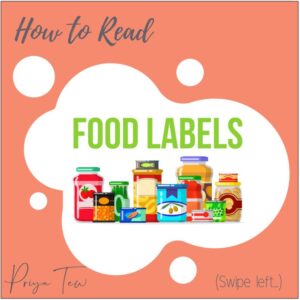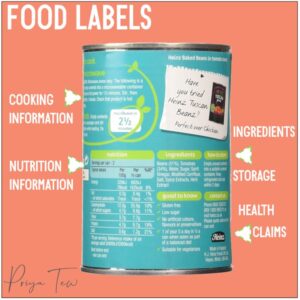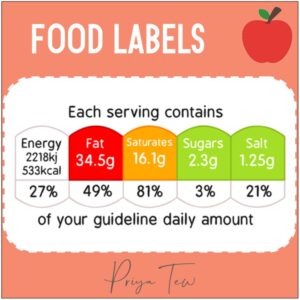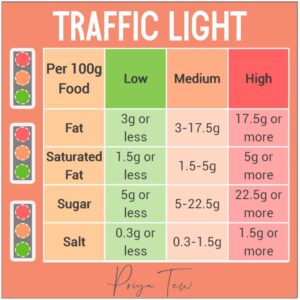Food labels can be confusing to interpret but it is key to know what you are eating and to compare products. Here is a very information post that will help you understand all you need to know about a food label.
Written by Naomi Leppitt, Community Dietitian.

A food label should be able to tell you:
- what the food is
- a ‘best before’ or ‘use by’ date
- how it should be stored
- provide cooking directions, if necessary
- a list of the ingredients in order of most to least in quantity
- any allergens such as milk, eggs, nuts, wheat written in bold.
- warnings eg ‘may have an adverse effect on activity and attention in children’
- country of origin eg for meat, fish, olive oil, wine, honey imported fruit and veg
- nutritional information
Note- Because the UK has now left the EU, food labels will change from January 2021.
Health Claims
Packaging often make claims like ‘low in fat’ or ‘no added sugar’ or ‘high in fibre’ or ‘one of your five a day’. Due to legislation, companies won’t be able to make claims that aren’t factual. However, it’s worth being aware of the food as a whole: for example, when a food company reduces the fat, the flavour will be impacted, so they often add sugar or salt to replace the flavour: this is often the case with yoghurts. Don’t just go by the claim, but read the information overall.
Pre-packed food shows a breakdown of the nutrients within the food:

- Energy, portrayed in kilojoules (kJ) and in kilocalories (kcals)
- Fat (in total) and ‘of which saturates’ which tells you how much out of the total amount of fat is saturated fat. This is highlighted because of the increased risk of cardiovascular diseases and diabetes with a diet high in saturated fat.
- Carbohydrates (in total) and of which sugars. Again, this breaks down how much sugar is in the food and that can include the added sugars, but also natural fruit or milk sugars.
- Fibre
- Protein
- Salt or Sodium
- Other vitamins or minerals may be included, particularly to back up a claim eg ‘source of calcium’ on a yoghurt
There are multiple columns:
per 100g is useful for comparing like for like products like comparing two types of cereal to choose the lower sugar option.
Per serving – useful for knowing how much you’ll actually be consuming. Note how many servings are in a packet.
Sometimes % RI is shown which means the proportion that that nutrient contributes to an adult’s recommended Reference Intake of 2000kcals.
The traffic light system:
Though this isn’t a legal requirement a lot of food companies use it on their food packaging. Red means high, amber is moderate, and green is low – just like a traffic light! Not all companies use it, and it’s likely because it makes it so clear just how high their product is in sugar / salt / saturated fat! We should all aim to choose more foods that are green or amber and less frequently choose foods that have a red code.

It is difficult for anyone to remember the numbers, hence the use of the colours of the system. But another way to remember it is that fat has 3 letters, and a low fat food has less than 3g of fat per 100g. Also, the word sugar contains 5 letters, and a low sugar food has under 5g of sugar per 100g!

- Total fat
- High: more than 17.5g of fat per 100g
- Low: 3g of fat or less per 100g
- Saturated fat
- High: more than 5g of saturated fat per 100g
- Low: 1.5g of saturated fat or less per 100g
- Sugars
- High: more than 22.5g of total sugars per 100g
- Low: 5g of total sugars or less per 100g
- Salt
- High: more than 1.5g of salt per 100g (or 0.6g sodium)
- Low: 0.3g of salt or less per 100g (or 0.1g sodium)
Sources
https://www.gov.uk/food-labelling-and-packaging/food-labelling-what-you-must-show
Pingback: How to read food labels – Nourish: Mind and Body